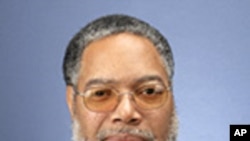The search is on for African-American treasures buried in attics, barns and elsewhere around the United States. Undertaking the project is Lonnie Bunch, tasked with the challenge of building the collection for the Smithsonian’s newest museum devoted exclusively to the documentation of African-American life, art, history and culture.
Mr. Bunch, who is founding director of the Museum of African-American History and Culture, recently spoke with Carol Castiel, host of VOA’s Press Conference USA, and VOA television correspondent Chris Simkins, about collection efforts, fundraising, and building design three years after the museum's historic inception.
Since then, Lonnie Bunch has sought public input regarding what types of exhibits people would like to see and what they hope the museum can communicate. His pursuit of artifacts has taken him to many local African-American history museums and communities across the country. He describes the quest for collection material as “one of the most humbling things” he has done in his career.
The “Save Our African-American Treasures” program, Bunch says, is one component of the search for historical items. The program brings people and their treasures to work with conservators to preserve “grandma’s shawl, or that old photograph, or that old plough sitting in the barn,” which are then sometimes donated to local museums. Items that are “really something of national significance,” Bunch says, are brought back to the Smithsonian’s collection.
The museum will emphasize themes of reconciliation and healing that Bunch hopes will allow people to have a dialogue on race that is “still one of the most difficult dialogues we have.” The museum will also strive to help many Americans and visitors from overseas “understand what race means in America and what it continues to mean.”
“People are interested in how we got to this moment, how our notions of race have changed over time,” says Bunch. He calls the election of Barack Obama as the 44th President of the United States a “profound change,” but that “it doesn’t mean the issues of race that once divided us are now gone.” According to Bunch, the public reaction to the museum has been positive. He says people have told him the most important thing the museum should do is “tell the truth” about the history of discrimination, segregation, slavery, and Jim Crow, but also to capture the resiliency and the optimism in the African-American community. Most of all, says Bunch, people tell him to “have faith that Americans can handle their difficult history.”
One example of the types of items they are looking for, Bunch says, is an embroidered pillow case a woman brought to the conservators. An enslaved woman gave the pillowcase to her daughter on the day she was being sold away. The embroidery read: “In this pillowcase I give you three dresses, I give you some bread, but I fill the rest of it with my love and that I may never see you again, but as long as you have this pillowcase, you will know that I’ve loved you.”
Architects from around the world competed for the honor of designing the museum building. Ultimately, a jury chaired by Bunch chose Ghanaian architect Freelon Adjaye and his firm, whose entry Bunch calls a “very positive and upward looking building” that will “no longer allow the African-American experience to be invisible.”
Technology will also be used in the museum exhibits. Bunch says the exhibits will “not be full of gadgets and gizmos” but instead will be a place that “uses technology as an interpretive and integral tool.” Using thousands of oral interviews, technology will allow visitors to explore a range of African-American experiences and the depths of their culture, from music like spirituals and hip hop, to the role of hair and adornment among African-American women.
One interview in the collection, recounts Bunch, is a grandfather interviewed by his grandson. The grandson asks the grandfather, “What was the saddest day of your life?” The grandfather tells of serving as an African-American soldier in World War II, and upon returning to the United States, visiting Washington, D.C. to see the nation’s capital and its monuments. At the end of the day, he went to a movie theater to see a show. He put his dollar on the ticket counter, and the ticket-taker said “Colored people aren’t allowed to come into this movie.”
Bunch says the interviews will let visitors learn not just about segregation, but “what it meant at that moment, for that individual, and how it stayed with him his whole life.”
“This is a museum whose time has come,” Bunch says. He praises Congress as the museum’s biggest donor and says fundraising progress around the country has been “wonderful.” With these funds, Bunch continues building his staff to do the behind-the-scenes work of starting a museum: planning exhibitions, doing research and building the collection, and continuing fundraising efforts.
Bunch hopes President Obama will participate in the groundbreaking ceremonies scheduled for 2012. The Museum of African-American History and Culture will join a number of other Smithsonian museums on the National Mall, and Bunch says it is on track to open in 2015.





